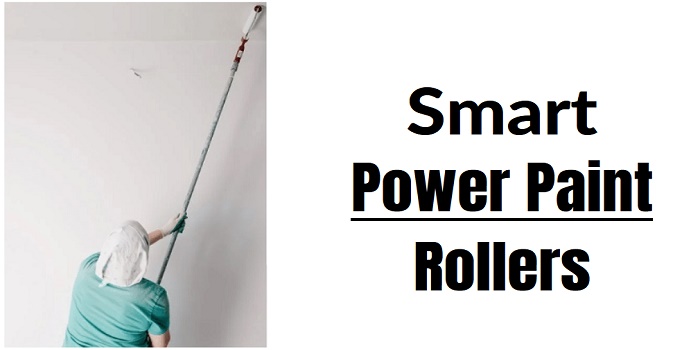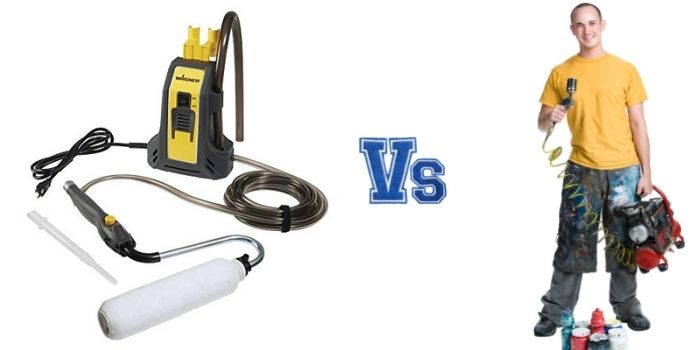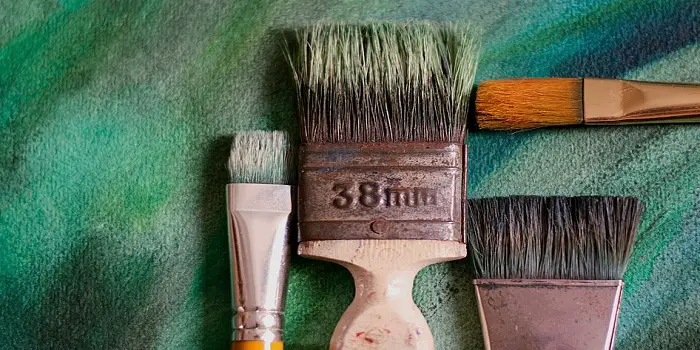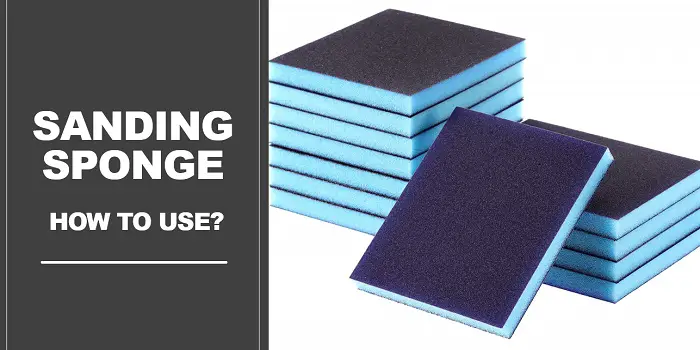
Power paint rollers are electrically operated paint roller machines that can make your rolling job much easier and fast.
These intelligent tools for painting often come with a built-in motor.
When switched on, these absorb the paint through a tube, store it in a reservoir and then release it through a roller sponge.
All the steps are easy to perform and are usually done with a touch of a button.
This means you do not have to worry about bending and dripping the paint when using these power tools for painting.
Some of these smart devices are also battery-operated and cordless, which makes rolling over large surfaces as simple as – a touch of a single button.
Benefits of Using Smart Paint Pump Roller
When painting your home, there are many reasons to choose a power paint roller over a traditional roller.
Here are just a few to think about.
1- Efficiency
A power paint roller eliminates the need to move several different pieces of equipment (like paint cans, trays, brushes) along the walls with you.
Instead, you simply fill the reservoir and start painting.
You can go back to your paint supply for a refill when you need it, but there is no need to move these things along with you.
2- Adaptability
Usually, a power roller will have a wide variety of options for roller types required for different surfaces and textures.
Also, the long extendable handles make it easy to reach even high walls and ceilings without the need for a ladder.
3- Coverage
With the proper use of a power paint roller, you will get professional-looking coverage every time.
The smooth flow of the paint means you will never have to break off mid-roll or begin to dry up partway through a wall.
Instead, the roller will maintain a steady stream that allows you to cover large areas of the wall uninterrupted by the need to reapply more paint.
4- Affordability
While a power paint roller will typically cost more than a traditional roller, the price is usually not at all unreasonable, and you get a lot more for your money.
Dollar for dollar, a quality power paint roller is more worth the investment than a traditional paint roller.
Also, when compared to sprayers, power rollers will use a lesser amount of paint.
However, if you compare them to traditional rollers, they will use more paint which can be a disadvantage if you want to save some paint.
5- Usage and Cleaning
Power paint rollers are designed to be easy to use, whether you are an experienced professional or a first-time painter learning how to do it yourself.
The setup is usually very simple, and using the power paint roller is not complicated.
Also, when it comes to cleaning, you have a number of options to make your roller reusable and keep it clean for use in the future.
6- Speed
Using the old slow and clunky rollers requires you to stop every few minutes to reapply the paint.
A power paint roller will save you an abundance of time and energy.
With the paint already there in the reservoir, released with the simple push of a button, it is not an exaggeration to think that you could cut the painting time in half, leaving you free to enjoy your freshly painted room and get on with your life.
7- Organization
Once the job is done, you will need to store away the equipment and leftover paint.
How great would it be if the only equipment you had to put away was the power paint roller?
Well, much of the old equipment needed to go along with traditional rollers is no longer necessary, making it that much easier to organize that storage space.

Power Rollers vs. Sprayers: What’s Better?
If you are wondering if a power paint roller system makes more sense for your paint project (rather than a paint sprayer), here are a few pros and cons.
| Power Roller | Sprayer |
|---|---|
| Good for beginners | Great for DIYers and PROs |
| Relatively inexpensive | Better speed and coverage |
| Easy to use and no overspray | Less tedious than brushing or rolling |
| Can deliver thin or thick coatings | Creates a smoother finish without roller marks |
| Requires less clean-up and maintenance | Delivers flawless coats on uneven, textured surfaces |
Power Paint Roller – Pros & Cons
Power roller machines are a great option for even large surfaces like hardwood floors, decking areas, interior or exterior walls, empty houses or unoccupied spaces, etc.
The only problem is it can’t paint the hard-to-reach areas very well.
The Pros:
Unlike sprayers, power paint rollers for house painting are much easier.
For the most part, simply reading the instructions before use will give you all the information you need to know about how to operate a power paint roller properly.
Another advantage is electrically powered paint rollers can be far less expensive than a paint sprayers.
For $40 or less, you can get a decent power paint roller that will get the job done.
Even if you spend more than $100 on a higher-quality power paint roller, you will still be spending much less than you would on a medium-grade paint sprayer.
The Cons:
Powered paint rollers are not all created equal.
If you buy one without due diligence, you risk getting a low-quality product that will either not function properly or break down in a short amount of time.
This also means electric-powered paint rollers can be more physically taxing than a properly used paint sprayer.
Using a power paint roller is easier on the muscles than a traditional roller, but a paint sprayer takes even less effort.
Paint Sprayer Machine – Pros & Cons
Spraying the paint or stain with a spray gun is a ‘contactless’ paint technique that is generally most suitable for uneven or smaller areas like kitchen cabinets, furniture, fencing boards, window door trims, etc.
These are recommended if you want a smoother finish without any texture marks, which can be a problem with rollers.
The Pros:
It is basically a painting power tool that is kind of fun to use for DIYers.
Paint sprayers apply the paint/stain evenly over almost any kind of surface.
Plus, they are known to deliver a high-quality, professional-grade look to any painting job.
Because paint sprayers use a fine mist of paint rather than a brush or roller, you can reach virtually any tight space or awkward corner with relative ease.
For instance, if you are painting furniture with unusual angles, or a wood fence with space between the boards, a sprayer can eliminate the need for brushes of all different sizes and shapes.
Paint sprayers can also get a job done very quickly.
Because the paint sprayers can keep a continuous flow going that does not require much attention as far as refilling or soaking brushes, you can complete a job in very short order.
The Cons:
The greatest downside of a paint sprayer is it costs significantly more than a power paint roller. Plus, it uses more paint than a roller.
Also, in the case of a paint sprayer, you really do get what you pay for.
If you are not willing or able to spend a significant amount of money, you will not likely get a high-quality product.
Most paint sprayers (like HVLP) are not as easy to use as traditional or power paint rollers.
These do require a certain level of expertise that other painting tools do not necessarily need.
This also means that there is a risk of creating quite a mess with a sprayer.
The paint is actually spraying out of the end of the spray gun, so one misstep can leave you with a real problem.
Final Thoughts
As you can see, many benefits make a power paint roller a really smart machine.
In fact, if you choose the right power paint roller system, it will be faster, more organized, and more efficient to give your wood painting jobs a professional look that traditional rollers simply cannot deliver.
With that said, also keep in mind that automatic paint roller machines are much faster than a traditional roller or a brush, but not quite as fast as a paint sprayer – assuming you know how to use the paint sprayer properly.
If you do not know how to operate them, both a paint sprayer and a power roller can be equally messy.
So, choose the one wisely based on your requirements and skills.
Share the post "Automatic Power Paint Rollers: Are They Really Smart?"

Douglas Becker (aka Painter Doug) has over twenty years of experience as a painter in Adkins, Texas. At present, he resides in Florida with his family.
From painting multi-storeyed houses, condos, and apartments to large commercial buildings and small offices, he had served various customers in areas not only in Adkins but also in Southwest Florida, Sarasota, Naples, and many more. To know more about him check here.




